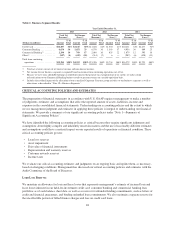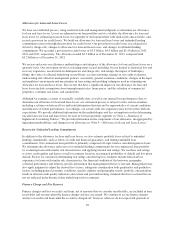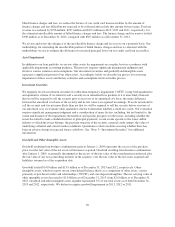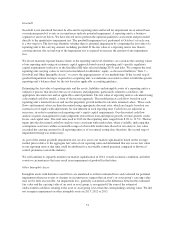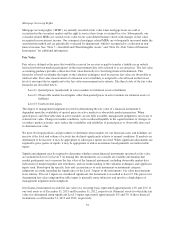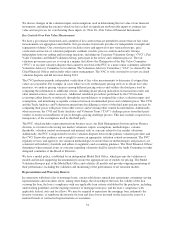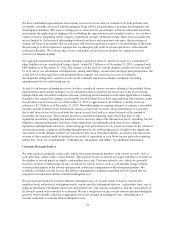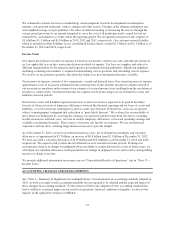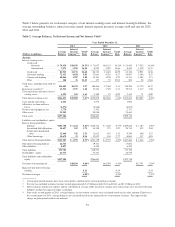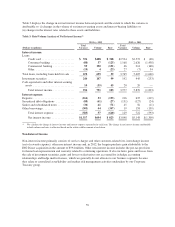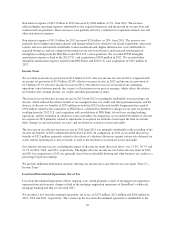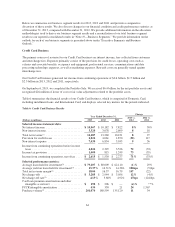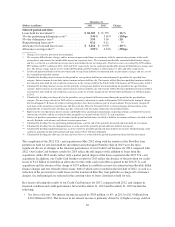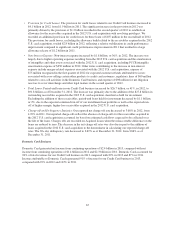Capital One 2013 Annual Report Download - page 78
Download and view the complete annual report
Please find page 78 of the 2013 Capital One annual report below. You can navigate through the pages in the report by either clicking on the pages listed below, or by using the keyword search tool below to find specific information within the annual report.Net interest income of $18.1 billion in 2013 increased by $1.5 billion, or 9%, from 2012, driven by a 4% increase
in average interest-earning assets and a 5% (30 basis point) increase in net interest margin to 6.80%.
•Average Interest-Earning Assets: The increase in average interest-earning assets in 2013 compared to 2012
reflects the full year impact of loans and investment securities from the ING Direct acquisition and the
addition of loans from the 2012 U.S. card acquisition. Growth in average interest-earning assets was also
driven by continued strong growth in commercial and auto loans, which was partially offset by the
continued run-off of home loans in our Consumer Banking business, the expected run-off of higher-margin,
higher-loss receivables acquired in the 2012 U.S. card acquisition and installment loans in our Credit Card
business, as well as the Portfolio Sale in the third quarter of 2013.
•Net Interest Margin: The increase in our net interest margin in 2013 compared to 2012 was primarily
attributable to a reduction in our cost of funds, which was due in part to the redemption of $3.65 billion of
our trust preferred securities on January 2, 2013, which generally carried a higher coupon than other funding
sources available to us. Our lowered cost of funds also reflects the continued benefit from the shift in the
mix of our funding to lower cost consumer and commercial banking deposits from higher cost wholesale
sources and a decline in deposit interest rates as a result of the continued overall low interest rate
environment.
Net interest income of $16.6 billion in 2012 increased by $3.8 billion, or 30%, from 2011, driven by a 46%
increase in average interest-earning assets, which was partially offset by an 11% (77 basis points) decline in our
net interest margin to 6.50%.
•Average Interest-Earning Assets: The significant increase in average interest-earning assets reflects the
addition of the ING Direct loan portfolio of $40.4 billion in the first quarter of 2012 and the addition of the
$27.8 billion in outstanding receivables acquired in the 2012 U.S. card acquisition and designated as held
for investment in the second quarter of 2012. Growth in average interest-earning assets was also driven by
continued strong growth in commercial and auto loans, which was partially offset by the continued expected
run-off of home loans in our Consumer Banking business, as well as the expected run-off of higher-margin,
higher-loss receivables acquired in the 2012 U.S. card acquisition and installment loans in our Credit Card
business. The run-off of home loans accelerated slightly as a result of the low mortgage interest rate
environment.
•Net Interest Margin: The decrease in our net interest margin in 2012 was attributable to a decline in the
average yield on our interest-earning assets, largely due to the shift in the mix of our interest-earning assets
to a larger proportion of lower yielding assets resulting from the acquired ING Direct home loan and
investment securities portfolios and temporarily higher cash balances from equity and debt offerings. The
ING Direct interest-earning assets generally have lower yields than our legacy loan and investment
securities portfolios. In addition, the establishment of a finance charge and fee reserve of $174 million in the
second quarter of 2012 for the receivables acquired in the 2012 U.S. card acquisition and premium
amortization related to the ING Direct and 2012 U.S. card acquisitions of $391 million in 2012 contributed
to the reduction in the average yield on interest-earning assets. The decrease in the average yield on interest-
earnings assets was partially offset by a reduction in our cost of funds. We have continued to benefit from
the shift in the mix of our funding to lower cost consumer and commercial banking deposits from higher
cost wholesale sources and a decline in deposit interest rates as a result of the continued overall low interest
rate environment.
58


